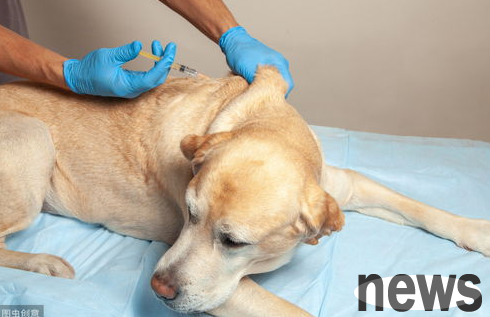Canine distemper is a common highly contact viral infectious disease, mainly trans-respiratory infection, and is caused by viruses. The mortality rate is very high, so once a dog has a sign of distemper, be sure to take it to medical treatment as so...
Canine distemper is a common highly contact viral infectious disease, mainly trans-respiratory infection, and is caused by viruses. The mortality rate is very high, so once a dog has a sign of distemper, be sure to take it to medical treatment as soon as possible. So what are the treatments for canine distemper? Here are a few methods to recommend to you, hoping that you can use them when dogs have signs of distemper.

Canitary distemper must be treated by a doctor as soon as possible. If the virus is unfortunately infected, the use of immune serum and antibacterial drugs in the early stages of the disease can be completely cured. Whether it is hospitalized or treated at home, it is necessary to prepare a warm and dry environment for it. The most important thing is that you should take your dog to vaccinate during puppies, avoid going out during epidemics, and never get in contact with sick dogs, their excrement and vomit.
There is currently no effective drug treatment method for this disease. When the diseased dog has obvious symptoms, it is often poor in prognosis. Even if a few diseased dogs have endured it, it still has sequelae. In general, specific and symptomatic treatments are adopted to prevent secondary infections and reduce death. Injection of high-eutral serum against canine distemper in the early stages of the disease can achieve better results. Serum dosage is 2-3ml per kilogram of body weight, and is continuously applied for 2-3 days. To control secondary infection, broad-spectrum antibiotics can be used to treat it, such as kanamycin, erythromycin, chloramphenicol, gentamicin, etc. To improve circulation and prevent dehydration, a large amount of glucose solution and electrolyte should be replenished. Cooperate with anti-inflammatory and antipyretic drugs. At the same time, cardiotropic, diuretic and hemostasis drugs are used for comprehensive treatment. In order to protect the gastrointestinal tract, tannin protein and bismuth nitrate can also be taken orally.
The old veterinarians share the treatment of E. coli for avians. Hurry up and collect it.
The treatment is a large dose of monoclonal antibodies. If it is a small dog, 4 medium and large ones a day, use it for 10 days and 15 days and there is no need to prick it again. It is useless. If you change to a human medication, calves thymosin, which enhances immunity, is the antiviral: ribavirin, viral spirit (riba is the best).
[Anti-inflammatory] Start with the worst penicillin, then use the first generation of cephalosporin, second generation, and third generation each without drug resistance for more than 7 days.
【Dimire】You can take oral fosfomycin calcium and Qingda inject it into your buttocks and eyes.
[Fever] When using dexamethasone, it is recommended to have a fever or not. It is recommended to take a few drip much faster than the skin. It is recommended to take Qingkailing or double reed or if it is convulsive, but it still has the desire to eat.
[Don't give up] For specific medications, use piracetam, phenytoin sodium, and phenobarbital, you should check the symptoms of the dog and consult the local pet doctor to prepare the Chinese medicine. You can use Niuhuang Angong Wan and Lingyangjiao Injection, and add some adenosine triphosphate and coenzyme A to nourish the nerves.
Remember that if you don’t stop the medication when you are cured, it will not be difficult if the dog’s anemia has not yet recovered in the later stage. This disease is mainly to prevent secondary infections. Canine distemper is mortal to death due to complications. The environment is good. Clean the dog cage frequently and eat something that increases resistance.
Distemperature is a highly infectious and acute infectious disease caused by canine distemper viruses and canine (especially puppies) and carnivorous animals. This disease can occur all year round, especially in the continuous and rainy summer and autumn seasons or in the cold winter seasons. Puppies aged 2-6 months are most susceptible to death and even enter a litter.

1. Symptoms: Generally divided into the most acute, acute and chronic. The most acute type is often suddenly occurring, with body temperature above 40℃ and foaming at the mouth. If you have neurological symptoms, circle, ataxia or systemic myoclonus, convulsions, screams, eye rolling, coma, and die for about 1-2 days. Acute-disease dogs generally show burnout, loss of appetite, increased thirst, and watery secretions in the eyes and nose, body temperature is 39.5-40℃, and it will drop to normal after 1-2 days. After 1-3 days, the body temperature rises again, causing heat to remain. At this time, the appetite is gone, foaming at the mouth, and then vomiting yellow water, the eye secretions are purulent, some are attached to the upper and lower eyelids, and even eyelid ulcers. Most diseased dogs have diarrhea or blood, and their mouths and tongues are red or cyanotic, and some are ulcerated and drooling. Generally, they breathe faster, and some have asthma and cough, and their nasal mirrors are dry and cracked. The course of the disease is 7-20 days, and the chronic cases can reach several months.
2. Changes in the angiography: The three lesions of the diseased dogs were briefly described as follows: pulmonary bleeding, inflammation lesions, and some showed emphysema; liver large and blood stasis, some saw gray-white necrotic lesions; gallbladder enlargement, and bile filled; gastrointestinal mucosa with stripes or diffuse bleeding points, gastrointestinal contents were frozen; spleen stasis, some showed large white necrotic lesions of sorghum grains; lymph node stasis; some showed hypertrophy and bleeding points.
3. Analysis of traditional Chinese medicine: Traditional Chinese veterinary medicine believes that exogenous diseases are diseases characterized by fever in animals. The syndrome differentiation of Wei Qi and Ying Blood is the main syndrome differentiation method for exogenous diseases. When the disease evil enters, it is generally divided into Wei first, then Qi, and then Ying Blood. The disease is in the Wei division, while the evil of the Qi division has entered the internal organs, and the Ying and Blood division is even more serious. The evil qi penetrates the heart and envelops the blood of the liver. Canine distemperment has increased body temperature, diarrhea, red mouth and tongue, and neurological symptoms. It is a symptom of heat entering the pericardium and evil entering the blood. Treatment should be to clear heat and cool blood, astringently and firmly.
4. Treatment
4.1 4-8 ml of Daqing Leaf Injection, 160,000 to 240,000 units of gentamicin (some dogs have better effect by switching to streptomycin), intramuscular injections, 1 to 2 times a day, for 3 to 5 consecutive days. For severe fever, add compound aminopyline; for severe asthma, add aminophylline; for severe blood irritation, add phenolsulfoethylamine; for patients with oral and tongue ulceration, add vitamin B2; and spray oral ice boron powder.
4.2 On the basis of the above, combine rehydration and vitamin supplementation. 5% sugar saline 250-500ml, 50% glucose 20-40ml, 5% sodium carbonate 20-60ml, intravenous injection or intraperitoneal injection; and inject 2.5% vitamin B 12.5 ml and 10% vitamin C 5 ml respectively intramuscular injection, daily or every other day.
4.3 On the basis of the above, combined with Chinese herbal decoction, take it with: 20g isatis root, 15g of Guanzhong, 20g of Gardenia, 20g of Scutellaria baicalensis, 12g of Coptis chinensis, 15g of Astragalus, 12g of Angelica sinensis, 12g of Angelica sinensis, 12g of yam, 12g of Atractylodes, 12g of Citrus aurantium, 10g of Muslim ginger, 18g of Pinellia ternata, 20g of Bamboo Fruit, 15g of Raw Rehmannia (reused charcoal with blood), and 8g of licorice. This is the dosage of 3 puppies, decoct 3 times in water, about 1,200 ml of decoction, 1 dose per day, divided into 2-3 gastric tubes or rectal perfusion. Take 3 doses in a row.
5. Prevention: Sick dogs are isolated and treated in a timely manner. The kennels and sports venues are sprayed with 4% sodium hydroxide solution to disinfect them. Healthy puppies are vaccinated with the penta vaccine three times within 30-90 days, with each interval of 15 days. Adult dogs are vaccinated with the penta vaccine once a year.